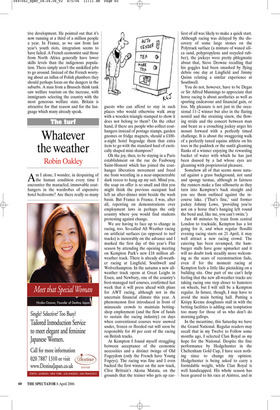Whatever the weather
Robin Oakley
Am I alone, I wonder, in despairing of the human condition every time I encounter the manacled, immovable coathangers in the wardrobes of expensive hotel bedrooms? Are there really so many guests who can afford to stay in such places who would otherwise walk away with a wooden triangle stamped to show it does not belong to them? On the other hand, if there are people who collect coathangers instead of postage stamps, garden gnomes or fridge magnets, should a £100a-night hotel begrudge them that extra item to go with the standard haul of exotically shaped mini shampoos?
Oh the joy, then, to be staying in a Paris establishment on the rue du Faubourg Saint-Honoré which has joined the coathanger liberation movement and freed me from wrestling in a near-impenetrable dark recess to hang up my suit. Mind you, the soap on offer is so small and thin you might think the previous occupant had left an after-dinner mint beside the wash basin. But France is France. I was, after all, reporting on demonstrations over employment laws in perhaps the only country where you would find students protesting against change.
We are having to face up to change in racing, too. So-called All Weather racing on artificial surfaces (as opposed to turf tracks) is inexorably on the advance and I marked the first day of this year’s Flat season by attending the opening meeting on Kempton Park’s new £18 million allweather track. There is already all-weather racing at Lingfield, Southwell and Wolverhampton. In the autumn a new allweather track opens at Great Leighs in Essex, and Newbury, one of the country’s best-managed turf courses, confirmed last week that it will press ahead with plans for AWT racing, although not in the uncertain financial climate this year. A phenomenon first introduced in front of minuscule crowds to maintain bettingshop employment (and the flow of funds to sustain the racing industry) on days when conventional courses were snowed under, frozen or flooded out will soon be responsible for 40 per cent of the racing on British tracks.
At Kempton I found myself struggling between acceptance of the economic necessities and a distinct twinge of Old Fogeydom (only the French have Young Fogeys). The racing was fine and I even backed the first winner on the new track, Clive Brittain’s Akona Matata, on the grounds that the trainer who gets up ear liest of all was likely to make a quick start. Although racing was delayed by the discovery of some large stones on the Polytrack surface (a mixture of waxed silica sand, polypropylene and recycled rubber), the jockeys were pretty phlegmatic about that, Steve Drowne recalling that his goggles had been smashed by flying debris one day at Lingfield and Jimmy Quinn relating a similar experience at Southwell.
You do not, however, have to be Degas or Sir Alfred Munnings to appreciate that horse racing is about aesthetics as well as sporting endeavour and financial gain, or loss. My pleasure is not just in the occasional 11–2 winner but also in the flaring nostril and the straining sinew, the flowing stride and the concert between man and beast as a crouching jockey urges his mount forward with a perfectly timed challenge. It is about the swaggering walk of a perfectly tuned equine athlete on his toes in the paddock or the sunlit gleaming flanks of a winner enjoying the rewarding bucket of water with which he has just been doused by a lad whose eyes are gleaming with proprietorial pleasure.
Somehow all of that seems more natural against a grass background, not sand and spongy tarmac, although in fairness the runners make a fine silhouette as they turn into Kempton’s back straight and you see them outlined against the incourse lake. (‘That’s fine,’ said former jockey Johnny Lowe, ‘providing you’re not on a horse that’s hanging left round the bend and, like me, you can’t swim.’) Just 40 minutes by train from central London to trackside, Kempton has a lot going for it, and when regular floodlit evening racing starts on 21 April, it may well attract a new racing crowd. The catering has been revamped, the hamburger stalls have gone upmarket and it will no doubt look steadily more welcoming as the scars of reconstruction fade, even if for the moment racing at Kempton feels a little like picnicking on a building site. One part of me can’t help feeling that the new all-weather tracks are taking racing one step closer to hamsters on wheels, but I will still be a Kempton regular. In future, though, I may have to avoid the main betting hall. Putting a Krispy Kreme doughnuts stall in with the betting facilities is adding one temptation too many for those of us who don’t do morning gallops.
In the meantime, this Saturday we have the Grand National. Regular readers may recall that in my Twelve to Follow some months ago, I selected Clan Royal as my hope for the National. Despite the fine performance by Hedgehunter in the Cheltenham Gold Cup, I have seen nothing since to change my opinion. Hedgehunter is being asked to carry a formidable weight, while Clan Royal is well handicapped. His whole season has been geared to his race at Aintree, and in his final prep run he actually won over hurdles. He has been second in the race before, he was unluckily taken out by a loose horse when leading last year and he is ridden by the incomparable Tony (AP) McCoy, who has yet to win a National and is desperate to do so. For the places I take François Doumen’s Innox, Eurotrek (if the ground is not too firm) and Hedgehunter. If you want something at a longer price try Haut de Gamme.











































































 Previous page
Previous page